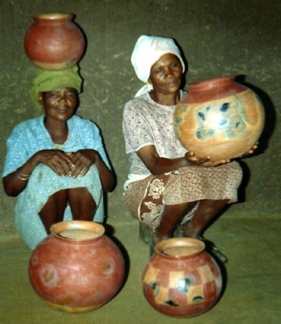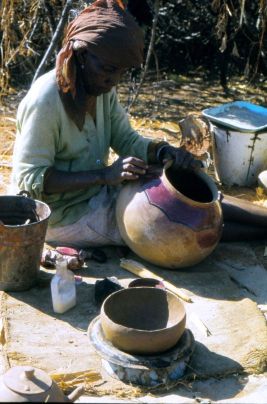© 2018 Dr. M. Sheppard
Potters and Pottery
Clay pots are usually made by women. It is a specialist craft. Clay pots are used in a variety of contexts. In the 1980s they were still used extensively for storing water and keeping it cool in the household as in Kanye and much of the Bangwaketse area there were few mains electric connections to households and gas or paraffin fridges were a luxury item.
Clay pots use clay and typically the clay pot makers will live near a fairly local supply. First they dig it out of the ground and then leave it to soak in water. Next they knead it into a d “dough”.
Clay pots are made in many sizes from the small to very large. They are used at traditional festivals suck as Dikgafela, weddings, funerals etc where traditional beer drinking plays a major part.
The pots are then left to dry and harden in the sun before applying decorations

Potters with their various pots ready for sale

Thongs are often tied around large pots to give extra support and as in this picture are rested on a pot support -

Clay pots are made from a special clay and typically the clay pot makers will live near a fairly local supply. Usually at their Lands or Cattle post. This activity can only be carried out during the dry season. First they dig it out of the ground and then leave it to soak in water. Next they knead it into a “dough”.

Some potters then build up the pot by rolling out a series of “rings” but this potter rolled out two halves which she then joined together and then shaped into the pot





Next the colour is applied to “paint” them red. This pigment is collected locally in the form of soft rocks which are then stemped into a fine powder and mixed with water. Then the “paint” is typically applied evenly with a flattened piece of bone or stick. Similarly black and yellow colour may be added to form additional decoration. These colours are from natural different coloured clays that are stemped into a fine powder before applying with a bone or stick
Shaping and smoothing out the pot. An upside down iron cooking pot lid is often used to rest the pot whilst it is being formed. This is rested in an enamel bowl so that the potter can easily turn it whilst she is shaping the pot




